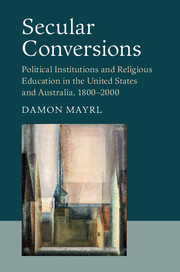 Secular Conversions
Secular Conversions Book contents
- Frontmatter
- Contents
- List of Figures and Tables
- Acknowledgments
- List of Acronyms
- Introduction
- 1 Politics, Institutions, and Secularization
- Part I Forging the nineteenth-century settlement
- Part II The nineteenth-century settlement in transition
- Part III Forging the twentieth-century settlement
- 5 Secularization and the Courts in Postwar America
- 6 Desecularization and Electoral Institutions in Postwar Australia
- Part IV Implications
- Epilogue: Toward a Twenty-First-Century Settlement?
- Index
6 - Desecularization and Electoral Institutions in Postwar Australia
from Part III - Forging the twentieth-century settlement
Published online by Cambridge University Press: 05 August 2016
- Frontmatter
- Contents
- List of Figures and Tables
- Acknowledgments
- List of Acronyms
- Introduction
- 1 Politics, Institutions, and Secularization
- Part I Forging the nineteenth-century settlement
- Part II The nineteenth-century settlement in transition
- Part III Forging the twentieth-century settlement
- 5 Secularization and the Courts in Postwar America
- 6 Desecularization and Electoral Institutions in Postwar Australia
- Part IV Implications
- Epilogue: Toward a Twenty-First-Century Settlement?
- Index
Summary
INTRODUCTION
Between 1964 and 1973, the nineteenth-century settlement that banned “state aid” to Australia's religious schools collapsed. A series of federal and state initiatives extended a trickle, then a torrent, of money to Catholic and other religious schools. By 1974, state aid was an accepted part of the Australian educational landscape, formally institutionalized in a new Schools Commission that doled out aid to religious schools on a recurrent per capita basis. The reintroduction of state aid represents the creation of a new settlement decidedly less “secular” than the one that preceded it. Whereas the former had refused any supportive relationship between the state and the churches in education, the new one treated church and state as collaborative partners in educational endeavors, under the banner of “religious neutrality.”
Why was state aid reintroduced in Australia, but not the United States? As in the United States, Australia's new secular settlement emerged thanks to a shift in the dynamics of religious conflict, a coordinated campaign to realize a new secular settlement, and a set of political opportunities made possible by favorable institutional terrain. In Australia, Catholics led the campaign for the new settlement. The dynamics of religious conflict shifted in the 1960s as the longstanding conflict between Catholics and Protestants was replaced by an ecumenical spirit that greatly reduced Protestants’ incentives to oppose state aid. At the same time, a split in the Australian Labor Party (ALP) led to the creation of a new, predominantly Catholic political party. This effectively transformed Catholics into political free agents whose votes were highly sought after, giving them powerful new leverage in federal and state politics.
This unprecedented political opportunity emerged in large part thanks to Australia's electoral institutions. Australia's preference-voting rules produced a relatively flexible party system with real political space for third parties. Catholics took advantage of this flexibility to create their own party in the mid-1950s, and manipulated the features of the preference-voting system to enhance their political influence during the 1960s. The institutional availability of the legislative pathway can be seen when the Australian experience is contrasted with a parallel campaign by Catholics for public aid in the United States.
- Type
- Chapter
- Information
- Secular ConversionsPolitical Institutions and Religious Education in the United States and Australia, 1800–2000, pp. 201 - 238Publisher: Cambridge University PressPrint publication year: 2016


